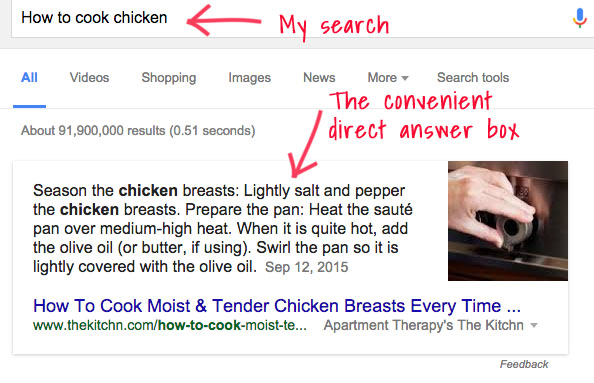Understanding Google’s Direct Answers and Their Impact on SEO

Among the recent SEO trends have been Google’s adoption of what is called the Quick Answer box. This box, which pops up at the top of search results for some queries, provides relevant answers to those queries. While the feature is designed to improve user experience, it is causing something of a stir among businesses and SEO professionals, who must now account for these direct answers in their own search engine optimization efforts. While direct answers cause some concerns for businesses, they also present a real opportunity to gain visibility for your business as you seek to maximize your SEO success in the coming year.
What are direct answers?
Simply put, direct answers are answers to search queries that Google generates and displays at the top of search results. For instance, a search for “how to brown meat?” brings up a Quick Answer box that contains beef browning instructions from bhg.com. Because these direct answers appear in boxes at the top of the search results, they are usually the very first results that searchers see. Typically, direct answers provide enough basic information on the subject to satisfy a casual searcher.

Example of a Google search showing a direct answer on the first page.
Direct answers consist of a number of elements. First, there is the answer itself, often quoted verbatim from a website that Google considers to be authoritative and well-organized. There is also a link to the web page from which the information is taken. Other elements that you might see include call-to-action links (such as “download now”), images, and tables. Direct answers are most often taken from an online source but are occasionally provided by Google itself.
Can direct answers hinder a business’s search engine optimization efforts?
Direct answers are a boon for search engine users, who can now find satisfactory answers to many of their queries without having to click through to a website. Improved user experience is one of Google’s primary goals and is, therefore, a driving force behind Google’s use of direct answers. However, while Google is interested primarily in the experience of its users, the concern of businesses is to generate traffic and leads through their sites.
As a result, many businesses have become concerned about the potential impact of direct answers on their own search engine optimization efforts. If users can get the answers they need at the top of the search results page, they may be less inclined to look at the other search results. Despite these concerns, however, there is little indication that Google will cut back on its direct answer efforts. In fact, the search engine appears to be expanding the number of queries that yield direct answers.
SEE ALSO: 2016 SEO Trends
What SEO opportunities do direct answers present?
Fortunately, it seems unlikely that direct answers can fully replace the valuable information provided within websites. Quick Answer boxes provide only brief instructions, definitions, or tables (i.e. the weather in a particular area, or a brief list of steps to complete a recipe). For many searchers, this information will only meet some of their needs, leaving them willing to look elsewhere for more detailed information. This means that websites can still attract the attention of searchers who want more than Google’s direct answers provide.
In addition, the Quick Answer box itself may be an important new opportunity within the search engine optimization landscape. Because it includes a link to the site that provided the direct answer, there is an opportunity for visibility and traffic generation for these sites. In addition, Google sometimes pulls information for its direct answers from sites that are not listed in the first three results. This means that there is an added opportunity for visibility for sites that are struggling to rank high in the search results.
How should websites optimize for direct answers?

As a result, new efforts to optimize for Quick Answers boxes are starting to arise within the search engine optimization world. The key, as always, is to highlight the value of your content to potential visitors. Following are a few of the ways that websites can organize their content in order to make it more appealing as direct answer material for Google:
-
Structure your data.
Structured data is a term that refers to information on a website that has been marked in such a way as to make it easier for search engines to understand. For Google, one way to implement structured data is to use schema.org. While search engine optimization services may be needed to successfully structure your data, the investment can result in improved search result listings and, possibly, the appearance of some of your material in Google’s direct answers.
-
Optimize your content for user experience.
Besides the technical aspects of structuring your data, you can also optimize your content for user experience in other ways. For instance, if you arrange lists of information (or steps in instructions) in clear and logical ways, it is easier for both visitors and search engines to understand.
In addition, you can take steps to target some of your content toward queries that lend themselves to direct answers. For instance, think about the types of questions that your customers might ask, and then develop quality content that answers those questions.
Finally, you can improve the appeal of your content for Google by including material (such as calls to action, videos, and compressed images) that contribute to the topic under discussion and that are easy for Google to link to or import into its Quick Answers box.
-
Use “how to” phrases in your content.
Finally, you can help to make your content more appealing by using “how to” phrases in your content. For instance, labeling a blog article as a “how to” article, or using the phrase to identify content that describes how to accomplish something can alert Google to the fact that your information might be useful for a direct answer.
Google’s Quick Answers boxes and direct answers do not have to mean that your search engine optimization efforts struggle. Instead, this feature presents a new opportunity to reach your audiences and gain visibility for your site. With the help of a skilled SEO service, you may be able to optimize some of your material to make these direct answers work for your SEO campaign.
Posted in: How To, Internet Marketing, Marketing, Search Engine Optimization, SEO, WWW Learning Center
Comments are closed.
Latest & Greatest
- Your Website is About Them, Not You: Digital Customer Experience
- Google Business Profile 101: How to Use it & SEO Benefits for Your Local Business
- The Power of Intentional Website Branding
- Competitive SEO Analysis: How to Keep an Eye On the Competition from an SEO Texas Agency
- Optimizing Your Online Registration Design for Better User Engagement
- Best Free Video Editing Software for Mac
- The Basics for Making Your Website More Accessible
